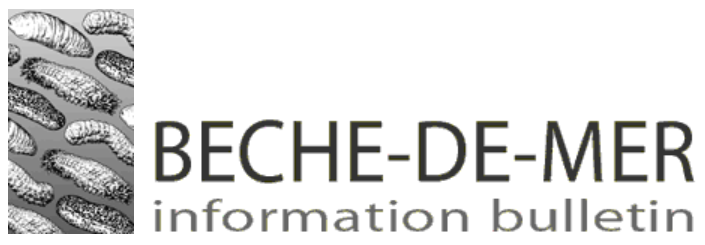
Group Coordinator and Bulletin Editor
Production
Pacific Community, Fisheries Aquaculture and Marine Ecosystems Division, Information Section, SPC, BP D5, 98848 Noumea Cedex, New Caledonia.
Produced with financial assistance from the Australian Government, the European Union, France and the New Zealand Aid Programme.
Editorial
This issue of the SPC Beche-de-mer Information Bulletin presents eight papers about sea cucumber aquaculture and taxonomy, and about the status of sea cucumber fisheries in various countries. At present, it is obvious that the management of sea cucumber fisheries is taken seriously into consideration in most countries. Many field studies have been undertaken showing that everywhere, and without exception, wild populations of commercial sea cucumbers are depleted. Ecologists have given their recommendations to concerned ministries in all beche-demer producing countries. We will see in the next few years whether their recommendations are followed, and if non-invasive harvesting methods such as aquaculture develop sufficiently.
The first paper, by Nyawira Muthiga et al., summarizes the recommendations resulting from a Marine Science for Management (MASMA) grant that provided funding for a regional sea cucumber project led by the Wildlife Conservation Society and the University of La Réunion.
Khalfan M. Al-Rashdi and Michel R. Claereboudt show that there has been a rapid decline in H. scabra populations due to overfishing in the Sultanate of Oman, resulting in an increased pressure on other sea cucumber species.
Chamari Dissanayake et al. provide preliminary results on the status of the sea cucumber fishery in Sri Lanka, where 4,000–5,000 families are dependant on sea cucumber fishing activities.
Ravinesh Ram et al. studied the impacts of harvesting and postharvesting processing methods on the quality and value of bechede- mer in Fiji Islands. This research raised concerns regarding the lack of general awareness and information on improvements in processing techniques at the fisher level, and sea cucumbers’ general significance within the overall coastal ecosystem.
Thierry Lavitra et al. investigated the effect of water temperature on the survival and growth of endobenthic juvenile H. scabra reared in outdoor ponds in Madagascar. Their study shows that water temperature does not affect the survival of H. scabra endobenthic juveniles, but it clearly affects their growth.
Daniel Azari Beni Giraspy and Ivy Grisilda Walsalam present their sea cucumber consultancy company, which offers hands-on training in the aquaculture and commercial production of sea cucumbers.
Yves Samyn et al. explain the basics of zoological nomenclature using examples of sea cucumbers.
Hampus Eriksson et al. studied the biology of Stichopus herrmanni at One Tree Reef, on the Great Barrier Reef in Australia. S. herrmanni can be found in very high densities in this protected area.
We briefly report on three spawning observations from the Indian Ocean.
Three PhD theses dealing with sea cucumbers have concluded successfully since the last issue. As usual, information and several publications are mentioned in this bulletin.
We close the issue with two impressive lists of publications on sea cucumbers by Prof Chantal Conand and Dr Claude Massin.
Contents
Muthiga N., Ochiewo J., Kawaka J. (pdf: 90 KB)
Al-Rashdi K.M., Claereboudt M.R. (pdf: 199 KB)
Dissanayake D.C.T., Athukorala S., Amarasiri C. (pdf: 583 KB)
Ram R., Friedman K., Sobey M.N. (pdf: 395 KB)
Lavitra T., Fohy N., Gestin P.-G., Rasolofonirina R., Eeckhaut I. (pdf: 285 KB)
Giraspy D.A.B., Grisilda Walsalam I. (pdf: 141 KB)
Samyn Y., Kerr A., O'Loughlin M., Massin C., Pawson D.L., Rowe F.W.E., Smiley S., Solis-Marin F., Thandar A.S., VandenSpiegel D., Paulay G. (pdf: 502 KB)
Eriksson H., Fabricius-Dyg J., Lichtenberg M., Perez-Landa V., Byrne M. (pdf: 162 KB)
Communications (pdf: 48 KB)
Abstracts and new publications (pdf: 102 KB)
Publications on sea cucumbers by Chantal Conand (pdf: 66 KB)
Publications on sea cucumbers by Claude Massin (pdf: 57 KB)

